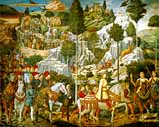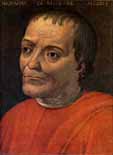
Cafaggiolo Villa
The origins of the House of the Medici family are to be found buried in the depths of the Tuscan countryside, in other words, in the Mugello, where the castle-villa of Cafaggiolo can be identified as their "cradle". However the first historical traces of the family were in Florence, where Salvestro, the son of Messer Alamanno dei Medici, joined the "common people" in the well-known revolt of the Ciompi (1378), the largest social upheaval in the history of the Florentine Republic. Originally farmers who had moved into the city, the Medici became first merchants and then bankers. The origins of their coat of arms, whose design was changed several times over the years, is not known. It was at first formed by eleven red balls on a golden field (the story that these were medicinal pills was apparently invented at the court of France by people wanting to defame Queen Caterina dei Medici in the 16th century); they became eight balls under Cosimo the Elder, while his son Piero the Gouty reduced them to seven: six were arranged in the shape of a triangle and one was placed in the centre; this was blue and painted with the lilies of France, according to a priviledge received from King Louis XI in exchange for diplomatic services. Lorenzo the Magnificent then reduced them to six, placing the blue ball at the top; Cosimo I, last of all, arranged them in the oval shape that they were to maintain in the future. Giovanni di Bicci (1360-1429, Bicci came from the nickname given to his father Averardo) was the founder of the family fortunes; by the early 15th century he had already accumulated a huge fortune thanks to his warehouses and banking interests as well as to his contract as rent collector for the City Council. Gonfaloniere in 1421, Giovanni became popular for his generosity for he often aided the Republic and the population in difficult times by providing financial help from his own personal fortune, while he was also the first patron of the arts in the family: he helped young Masaccio and paid for the reconstruction of the Basilica of San Lorenzo out of his own pocket (which stood in the area of the city where the Medici lived), entrusting the project to Brunelleschi. Two sons were born of his marriage with Piccarda Bueri: Cosimo (1389-1464) and Lorenzo (1395-1440), both of them called "the Elder", from whom the two branches of the family originate.

B.Gozzoli,
Procession of the Procession of the Magi
With varying fortunes, the direct descendants of Cosimo were to be Lords of Florence until 1537: these were Piero the Gouty (1416-1469), who married Lucrezia Tornabuoni, Lorenzo the Magnificent (1449-1492), whose wife was Clarice Orsini, Piero the Unfortunate (1471-1503 though he was more incompetant than unlucky), who was married to Alfonsina Orsini and Lorenzo Duke of Urbino (1492-1519), married to Maddalena de la Tour d'Auvergne of the royal house of Bourbon. The last legitimate descendant of this branch was Caterina (1519-1589), later Queen of France, but Florence instead found itself ruled over by Alessandro the Moor (1510-1537), the first Duke of Florence and bastard son of Giulio dei Medici (1477 c. - 1534), who became Pope Clement VII and who was, in his turn, the bastard son of Giuliano dei Medici (1453-1478), Lorenzo the Magnificent's much loved brother, who was killed in the Pazzi plot. Giovanni, Lorenzo the Magnificent's second son, was to become famous as Pope Leo X (1475-1478): he protected artists and writers at the papal court but also had to deal with Luther's Reformation. Meanwhile the descendants of Lorenzo dei Medici the Elder lived in the shadow of the senior branch and, at times, also took advantage of the disadventures of the more powerful family or did what they could to cause trouble, as was typical among the rebellious elements to be found in most reigning houses. Lorenzo the Elder and Ginevra Cavalcanti produced Pier Francesco, also called the Elder (1430-1476), who married Laudomia Acciaiuoli; he fathered Lorenzo (1463-1503), lord of Piombino, and Giovanni (1467-1498); at this point the cadet branch split up again into two new branches and this was to be of some importance a few decades later. Both brothers left off calling themselves Medici and rebaptized themselves "Popolani" in 1494, right at the time that Piero the Unfortunate was thrown out of Florence, an event that was partly the result of their plotting.

Giovanni di Bicci,
the firtst of Medici
Lorenzo the Popolano was the father of Pier Francesco the Younger (1487-1525), who married Maria Soderini and in his turn fathered Lorenzino (1514-1547), who was to murder Duke Alessandro in the name of apparent Republican ideals, thus cancelling out the branch of Cosimo the Elder and earning the name of Lorenzaccio (or wicked Lorenzo). Military leader Giovanni dalle Bande Nere (1498-1526), was instead the son of Giovanni the Popolano and Caterina Riario Sforza and father, in his turn, of Cosimo I, the founder of the dynasty of the Medici Grand Dukes, who were to rule over Tuscany until 1737. By a strange coincidence, Cosimo riunited the two branches of the family: Maria Salviati, his mother, was in fact a Medici through her mother and the blood of Lorenzo the Magnificent ran in her veins. In spite of this, however, Cosimo did not feel really sure of his throne until his hired assassins had murdered his second cousin Lorenzaccio, who would in fact have been, by right of primogenitureship, the legitimate heir to the title of Duke. The blood of the two main branches was to mix together again (just by historical chance) in 1587, when Ferdinando I, the younger son of Cosimo I, was forced to succeed to the throne when his brother Francesco I died without male heirs: he then decided to marry Cristina of Lorraine, whose maternal grandmother was none other than Caterina dei Medici, the last direct and legitimate descendant of Lorenzo the Magnificent.
